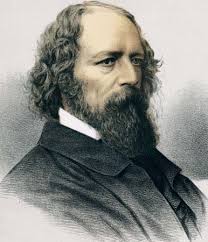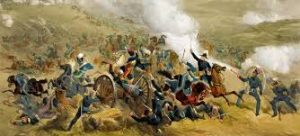Alfred Lord Tennyson was a stalwart of the Victorian era poetry. His most famous poems were ‘In Memorium’, ”Ulysses‘, ‘The Lady of Shallot‘ etc.

We shall be seeing another one of his poems which is ‘The Charge of the Light Brigade’.
The Charge of the Light Brigade Text
Summary of ‘The Charge of the Light Brigade’
The poem relates the account of a brigade of 600 men that went on horseback for half a league into the “valley of death.” They were following orders to rush the opposing soldiers who were snatching their firearms.
The instruction to rush forward did not dissuade or disturb a single soldier, despite the fact that everyone knew their superior had made a horrible mistake: “Someone had blundered.” The soldier’s responsibility is to obey and “not to make a reply…not to reason why,” so they obeyed and galloped into the “valley of death.”
The 600 men were attacked by cannon shells fired directly ahead and on all sides of them. Nonetheless, they rode bravely toward their own deaths.
While the rest of humanity watched in awe, the troops hit the opposing raiders with their extremely sharp swords and charged at the enemy army. They rode through the smoke of artillery and burst through the opposing line, annihilating their Cossack and Russian foes. Then they decided to head back from the attack, but they had sacrificed many men and were no longer “the six hundred.”
Canons behind and from both sides of the military men now violently attacked them with shots and artillery rounds. As the battalions rode “back from the mouth of hell,” military men and horses started to collapse; few managed to remain to continue the journey back.
The world rejoiced at the troops’ bravery; truly, their greatness endures: the poem asserts that these gallant 600 men are still deserving of praise and gratitude today.

The 600 soldiers were assaulted by the shots of shells of canons in front and on both sides of them. Still, they rode courageously forward toward their own deaths. They fought courageously and bravely, even if it meant that it would lead them to their deaths.
Then they rode back from the offensive, but they had lost many men so they were “not the six hundred” anymore. As the brigade rode “back from the mouth of hell,” soldiers and horses collapsed; few remained to make the journey back.
Structure
Alfred Tennyson’s poem “The Charge of the Light Brigade” is structured into six stanzas. Each stanza has a set range of lines. The poem contains 55 lines in total. The final stanza is the shortest. The poem’s brief yet vigorous words are reminiscent of military activity. The poem’s words travel quickly and attempt to mimic the beat of the battlefield.
The poem does not follow any rhyme system. Some sentences, however, rhyme in order to resonate with the military mood. As a result, it is a poem in blank verse.
The poem’s metrical rhythm replicates the sound of a military footfall. The poet employs brief lines to emphasize the poem’s tone.
Literary Devices
Alfred Tennyson’s ‘The Charge of the Light Brigade’ features some major literary elements. The author employs a Palilogy in the opening two lines of the poem.
In the third verse, the poet employs the battlefield Metaphor “the valley of Death.”
In the same sentence, the poet capitalizes the initial letter of “Death.” This implies that he is also employing a Personification here. The poet alludes to the men of the Light Brigade in the next line by using the word “six hundred.”
It is the application of Metonymy. As a Refrain, the poet employs the words “Rode the six hundred.”
Detailed Analysis
Alfred Lord Tennyson penned ‘The Charge of the Light Brigade’ in reaction to the Battle of Balaclava in the Crimean War, in which British cavalry stormed over open territory. With 637 soldiers, the British charged against Russia in what Alfred Lord Tennyson described as a fatal charge. “Russia aspired to dominate the Dardanelles” at the time, which would have “jeopardized British marine lanes”. Florence Nightingale, who treated injured troops during the battle, helped make this war famous.
The poem begins with the words “Half a league,” which are repeated three times to produce a lyrical effect as well as to represent the light brigade’s procession towards the opposition during the Crimean War. A league is an archaic unit of measurement that is roughly equivalent to 3 miles. As a result, half a league equals 1.5 miles.
The men were told to advance towards the enemy state, which was most likely 1.5 miles away. They were six hundred in number, and they were walking in the Valley of Death, according to the poet. The poet used the phrase “valley of Death” to indicate that the soldiers (the Light Brigade) will be slain shortly.
The commanding officer referred to as “he” in the poem, orders the soldiers to go towards the adversaries and charge (attack the enemies) in order to grab their guns or, more likely, to eliminate those holding the firearms.
The second stanza opens with their commander’s command, “Forward, the Light Brigade!” The poet asks if any of the troops in the brigade were scared because of the terrible danger ahead, and replies that they didn’t know which dread they were afraid of, albeit the concept of moving towards the enemy was a folly done by somebody else (means their leader).
However, the troops were faithful and courageous enough not to ask their captain to return or to dispute his command. They had only one goal in mind: to fight and die for their nation, so they proceeded further into the Valley of Death.
The third stanza depicts the moment in which they are besieged by their adversaries. The poet describes their location as Cannon to their right, Cannon to their left, and Cannon ahead of them. That is, there were enemy cannons ready to shoot them down from all directions.
Bullets and shells from the guns and cannons were flying through the air. They didn’t halt, instead plunging into the jaws of Death and the mouth of Hell.
In the fourth stanza, to attack the enemies, the warriors used their sabres bare, or blades. Despite possessing swords, they battled fiercely and killed the gunners. The entire world was amazed that they risked to fight using light weapons while their opponents had guns and cannons.
After crossing the border, the men marched through the dense fog of shelling towards the enemy’s guns. They battled and slaughtered their adversaries, the Cossacks, and Russians. Their strikes were so powerful that their opponents shook in horror and were ripped apart to death.
They returned, although according to the poet, there were not six hundred of them, implying that many of them died. The poet laments the devastating loss here.
To describe the battle zone within which they were confined, the five lines of verse 3 are repeated in stanza five. Many of those (designated heroes by the poet) died alongside their horses, yet they battled valiantly. They returned from the mouth of hell, everything that was left of them, i.e., those who were still living.
The poet asks rhetorically in the final verse, “When can their splendor fade?” i.e., their greatness and the wonderful act (i.e., the daring charge or heroic attack they launched) will be remembered by Britishers forever.
According to the poet, the world marvelled at their feat, referring to those 600 valiant troops.
FAQs
What is the message in ‘The Charge of the Light Brigade’?
The Charge of the Light Brigade is an emotional poem that simultaneously praises and laments the battle’s conduct. During the Crimean War, the concept of the heroic and gallant British soldier, whose moral mission was to fight for justice, arose. Previously, military heroes were upper-class gentlemen.
What does the valley of death mean in ‘The Charge of the Light Brigade‘?
The poem relates the account of a brigade of 600 men that went on horseback for half a league into the “valley of death” (about one and a half miles). They were following orders to rush the opposing soldiers who were snatching their firearms.
Did anyone survive ‘The Charge of the Light Brigade’?
Lord Cardigan’s light cavalry brigade engaged Russian artillery in “the valley of death” during the charge. The brigade repulsed the gunners but was assaulted by around 2,160 Russian light cavalries. It had 469 of its 664 cavalrymen killed. The 195 survivors withdrew, outnumbered 11-to-1.
Why does the poet say that someone had blundered?
This is due to a misunderstanding in the line of command, which caused the mission to be suicidal. Because a blunder is a disastrous error, Lord Alfred Tennyson refers to it as someone having (blundered).
Introduction to Tennyson
Tennyson wrote the poem in memory of the brave English soldiers that died during the Crimean war in 1854. The poem glorifies war and courage, even in cases of complete inefficiency and waste, and through this poem, we see Tennyson’s acceptance and support of the war.
The poem remains a famous war epic because of its rhythmic stanzas and repetition of words (Half a league/half a league/ half a league onward). The poem attempts to comprise the military integrity of repetition to enhance a feeling of patriotism in the reader.